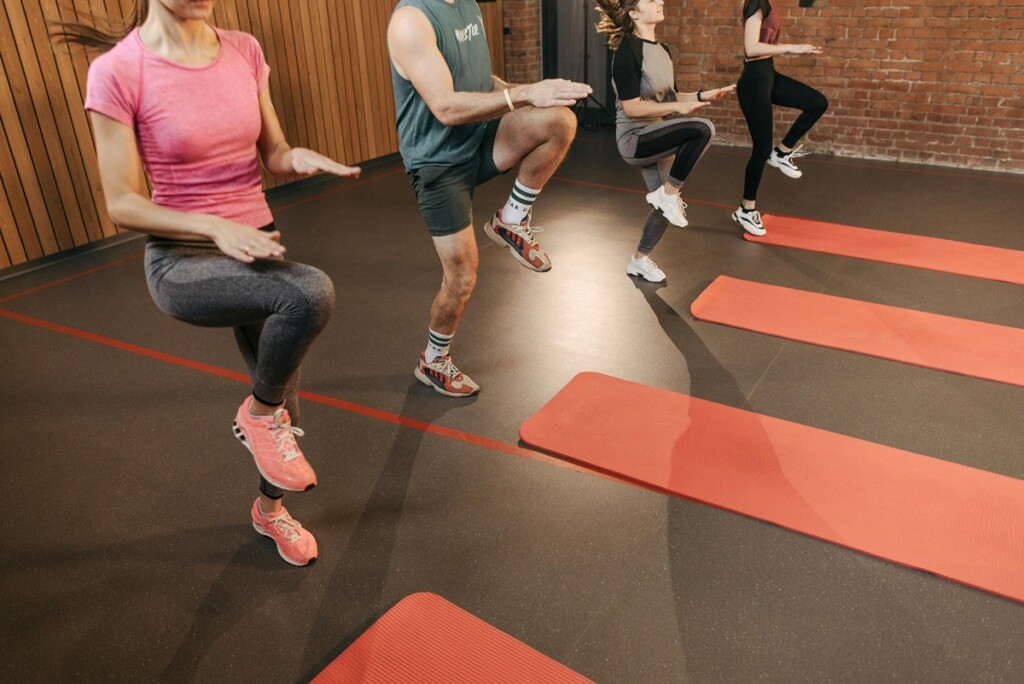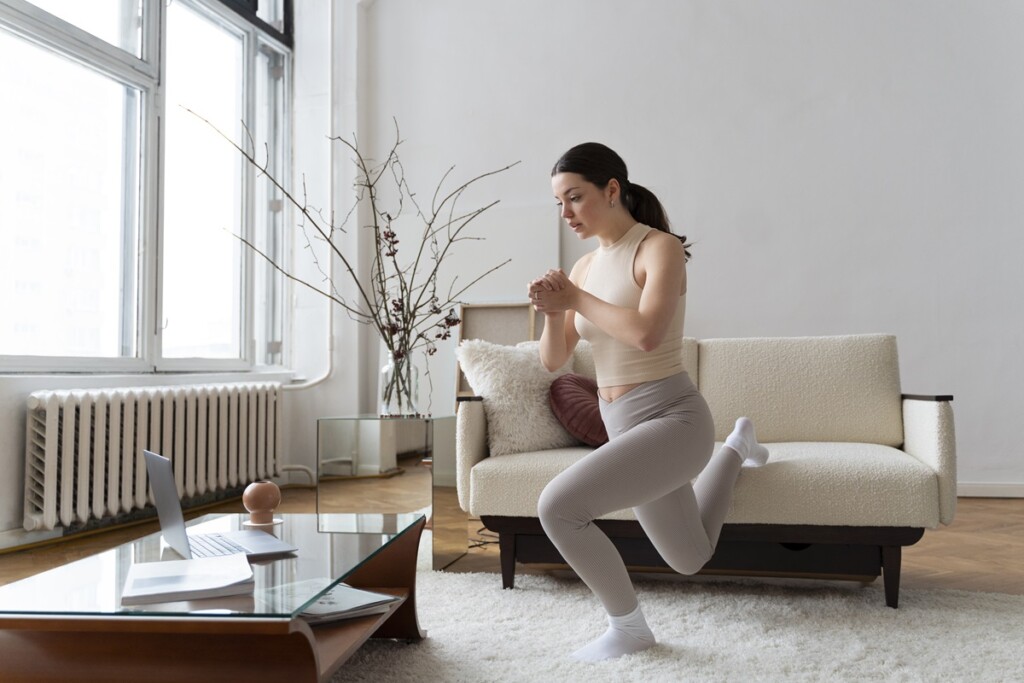When it comes to shedding those extra pounds, you may be on the lookout for efficient and convenient workout routines. You’ve likely heard about running in place as a potential solution — after all, it seems like a simple and accessible workout that you can do almost anywhere. But how effective is it for weight loss?
Coach Amanda was dubious about this whole workout thinking you’d be better off doing a tabata or HIIT workout. Including some shorter high intensity movements, but Beth is here to explore if there might just be some thing to this stationary routine, particularly if you aren’t in a place to push yourself with burpees and high knees.
If you want to get cheeky, the treadmill is running in place to a lot of folks ;)
Running in Place vs. Regular Running: What’s the Difference?
When it comes to cardiovascular exercise, both jogging in place and running outside offer ways to get your heart pumping and calories burning. However, they differ in a few key aspects.
Regular running involves propelling yourself forward over a distance, whether it’s on a treadmill, track, trail or pavement. This forward motion engages your leg muscles in a more dynamic way, requiring you to push off the ground and move yourself forward with each stride.
Running allows a greater range of motion than running in place, as you can stretch your legs fully with each step. This increased range of motion strengthens your hips and ankles, more than running in place.
All of that combined leads to a higher calorie burn and greater heart benefits, especially when running at a moderate to high intensity. According to calorie burn calculators you’re burning about 20-30% more calories running than jogging in place.
Advantages of Running in Place
Just because it’s a lower calorie burn doesn’t mean it can’t be worthwhile when you have limited options!
Jogging in place offers several benefits, making it a convenient and effective form of exercise. Whether you’re short on time, space or access to safe outdoor running routes, jogging in place can be an excellent alternative to traditional running workouts. Here are some key advantages:
#1 It’s Accessible for Everyone
One of the most significant benefits of jogging in place is its accessibility. You don’t need any equipment, access to a gym or running track to do it. All you need is a small space to move around, making it perfect for those who prefer to exercise at home or don’t have access to safe outdoor running routes.
#2 It’s Convenient
You can run in place anywhere, anytime. Whether you’re at home, in a hotel room or even at the office during a break, you can squeeze in a quick session to get your heart rate up. This makes it easy to incorporate into your daily routine, helping you stay consistent and limit any excuses.
#3 It’s Lower Impact
Compared to outdoor running or running on a treadmill, running in place can be low impact, meaning it puts less stress on your joints. Since you’re not subjecting your body to the impact of landing heavily with each step, it can be a safer option if you experience joint pain or injuries.
#4 It Benefits Your Heart
It’s an effective cardiovascular workout that can improve your heart health and stamina. By increasing your heart and breathing rate, running in place strengthens your heart and lungs, improves circulation and boosts your cardiovascular fitness.
#5 It Burns Calories
You can burn a lot of calories by running in place at a vigorous intensity. By continuously lifting your knees and pumping your arms, you engage multiple muscle groups and elevate your heart rate, increasing calorie expenditure.
#6 It Engages Multiple Muscle
While running in place primarily targets your lower body muscles, including your quadriceps, hips, hamstrings and calves, it also engages your core and even your upper body to some extent.
By incorporating arm movements and maintaining proper posture, you can tone and strengthen your muscles while jogging in place.
Is Running in Place Good for Weight Loss?
Running in place can be effective for weight loss when combined with a balanced diet, strength training and likely some other cross training. No single workout is going to shed the pounds without some other changes.
For instance, eating a balanced diet high in protein and omega-3 fatty acids can accelerate results by providing essential nutrients for joint health, muscle growth and heart health. Including protein sources like lean meats, fish, eggs and legumes supports muscle growth and recovery, while the omega-3s in fish, nuts and seeds reduce inflammation and improve cardiovascular function.
While it may not burn calories at the same rate as outdoor or treadmill running, it still offers a significant calorie burn. It elevates your heart rate and works multiple muscles, therefore increasing your metabolic rate and allowing you to burn more calories during and after your workout.
Additionally, because it’s accessible and convenient, you can easily incorporate it into your daily life, helping you stay consistent.
If working out at home is key to your success and weight loss is the goal, consider a few additional workouts.
- Building muscle will increase your total daily calorie burn and improve your overall physique. Checkout these bodyweight strength moves to get started.
- Adding in some variety to your cardio will also help ensure you work different muscles. Checkout these indoor workouts for more ideas like a jump roping workout.
- Not sure where to start with protein? Here’s a guide to learn more about protein for runners and how it will help you slim down.

Does It Count Toward Your Daily Steps?
Absolutely. Most fitness trackers and apps may count your arm and leg movements as steps or equivalent activity, especially if they detect motion.
If you’re unable to leave the house due to bad weather or other factors, then running in place is a fantastic way to still reach your 10,000 steps a day goal.
While running in place can certainly contribute to your overall physical activity level, it’s essential to consider it as a complementary activity rather than a substitute for walking or running outdoors. Remember that it’s probably not going to get you ready for a race, but instead act more like a cardio workout class.
If you aim to achieve a certain step count goal, it’s best to incorporate various activities throughout the day, including walking, running and other forms of exercise, to ensure you meet your targets while enjoying the benefits of a well-rounded fitness routine.
How to Maintain Proper Form
Maintaining proper form during any workout is vital to maximize its effectiveness and minimize the risk of injury. Pay attention to these key elements of proper form to prevent any injuries:
- Stand tall with your feet hip-width apart
- Keep your arms relaxed by your sides, releasing tension from your shoulders
- Lift your knees toward your chest, aiming for hip height (knees up, not feet back like kicking the butt)
- Swing your arms naturally, bent at a 90-degree angle
- Engage your core for stability and posture
- Avoid excessive leaning forward or backward
- Land softly on the balls of your feet to reduce impact on your joints
- Maintain a steady rhythm and breathing pattern
Why Does Running in Place Feel Easier?
Jogging in place may feel easier for several reasons.
Since you’re not moving forward, there’s no wind resistance to overcome, making the activity feel less taxing on your body. Additionally, there’s no uneven terrain or hills, eliminating the need to adjust your pace or exert extra effort to navigate obstacles. This results in a smoother and more controlled movement.
The lack of external distractions and environmental factors allows you to focus solely on maintaining your rhythm and form, which can contribute to ease and comfort during the workout.
The movement also involves shorter strides traditional running. This shorter range of motion can reduce the impact on your joints and muscles, making the activity feel less strenuous overall. Since you’re not using muscles to propel yourself forward, you may feel like you’re putting in less effort, even if your cadence is the same as outside.
To make it harder, you can increase your speed, swinging your arms faster or as noted above change it in to a HIIT style workout.
How Effective is Jogging in Place?
Jogging in place can be an effective form of cardiovascular exercise, especially for those seeking convenience and accessibility. While it may not burn as many calories or engage as many muscles as regular running, it still offers significant benefits for improving heart health, increasing stamina and burning calories.
Its low-impact nature makes it suitable for individuals of all fitness levels, including beginners and those with joint issues or injuries. However, to truly maximize its effectiveness, it’s essential to maintain a consistent workout schedule, gradually increasing intensity over time and complementing it with other forms of exercise and a balanced diet.
While running in place and regular running are effective forms of cardiovascular exercise, they differ in terms of calorie burn, muscle engagement and impact on the joints. If you’re looking to shed some extra weight then combining jogging in place with other healthy habits may help you reach your goals.
All articles are reviewed and edited by Owner and Coach Amanda Brooks.
Beth Rush is the Managing Editor at Body+Mind and a lover of all things health and wellness. She is a well-respected writer in the personal wellness space and shares knowledge on a variety of topics related to nutrition, fitness, holistic health and disease prevention.
Other ways to connect with Amanda
Instagram Daily Fun: RunToTheFinish
Facebook Community Chatter: RunToTheFinish
Sign Up to Receive a Weekly Newsletter with Top Running Tips and Laughs



 On Cloudmonster Hyper Review vs Cloudmonster
On Cloudmonster Hyper Review vs Cloudmonster
